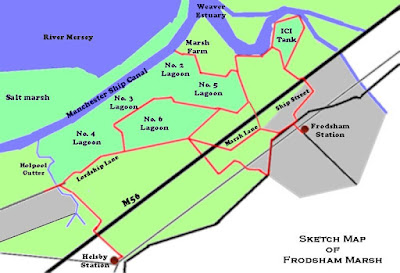 |
| Sketch map of Frodsham Marsh |
I don't visit Frodsham nearly as often as I should. Frodsham village is pretty, easily accessible by train and the marsh offers some very good birdwatching. The habitat is a mixture of wet farmland and water management lagoons bound by the M56, the River Weaver and the Manchester Ship Canal. I treat the brook called Holpool Gutter as the western boundary. Further west lies Ince Marsh.
The rivers and lagoons attract wildfowl and waders, the fields and lagoon edges attract good numbers of passerines and both these attract the attention of birds of prey.
Sadly the excellent Frodsham Marsh Bird Blog is no more. The last time I checked the annually-updated site list currently standing at 261.
This is a working area; most of the paths are used by vehicles. Be prepared to encounter potholes and muddy patches of track.
 |
| Lordship Lane |
- Turn right, cross the road and turn into Ship Street to go down to the eastern end of the marsh.
- Turn left, cross the road and continue down then turn into Marsh Lane to go down to the central part of the marsh.
(In principle it should be possible to go straight to the western end of the marsh from Ince or Helsby stations but I've never done it.)
Both routes take you over the M56 and through wet farmland. The finch flocks are mostly linnets, goldfinches and chaffinches. You might strike lucky and see one of the coveys of grey partridges.
Ship Street
Ship Street narrows after it crosses the motorway and eventually takes you down to the Weaver Bend. There is nearly always a variety of ducks and waders on the river and it's always worth working your way through them in the hope of finding something unexpected, even if it's "only" a wintering common sandpiper. As you follow the bend round clockwise you'll find yourself walking around the ICI Tank and eventually back to the lane that becomes Ship Street. From here you can either retrace your steps and walk back to Frodsham or you can complete the circuit and walk along the river towards Marsh Farm and then either walk down the path towards Manchester Ship Canal or walk down Brook Furlong Lane to explore the lagoons. |
| Don't be too dismissive of the factories beyond the marsh: they're favoured perching places for peregrines. |
Marsh Lane
If you turn left and go down the main road you'll pass a lot of very picturesque buildings (nearly all of which have heritage plaques on the wall) before you come to Marsh Lane. Walk down here until you get to a fork in the road. The road to the right goes over the motorway and becomes Brook Furlong Lane. If the weather's been very wet lately this is probably the best route into the centre of the marsh — it's the shortest route and the track's in better condition.I generally turn right and follow Marsh Lane to its end. (It wasn't until I started putting the notes together for this blog that I realised I usually walk clockwise around sites.) The lane runs parallel to the M56 for a while giving you a chance to check out the field and hedgerows on this side. Be careful as the noise of the motorway traffic can drown out that of vehicles coming along the lane. Once over the motorway the state of the track becomes pretty lamentable. It can be worth it, though, particularly in Spring when the fields are peppered with wheatears and other passerines on passage migration.
Eventually you'll come to the junction with Lordship Lane at the model aircraft flying field. This stretch of Lordship Lane follows the southern boundary of No. 6 Lagoon. A circuit of this lagoon is well recommended. Whichever direction you take as you walk down the lane it's worth keeping an eye out for stonechats, there's usually a pair or two hereabouts. No. 6 Lagoon is the only one with a large stretch of standing water; the eastern half is shallow open water and the western half is under reeds. This water can hold large numbers of ducks and waders.
 |
| Black-tailed godwits, No. 6 Lagoon |
 |
| Raven. This was one of the thirty-odd ravens kicking about No. 3 Lagoon late on a Winter's afternoon. |
A steady meander round stopping regularly to enjoy the view and try and find out whatever it was that flew into that bush over there would take two or three hours, a lot less if you get a push on and/or just go round one part of the matsh.

No comments:
Post a Comment